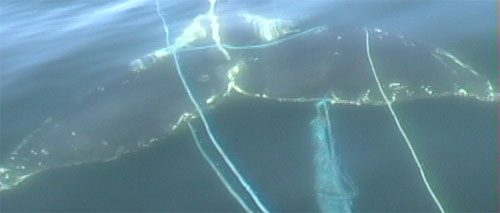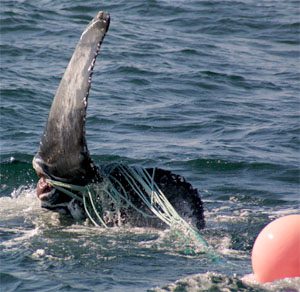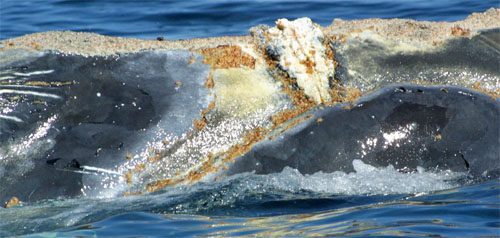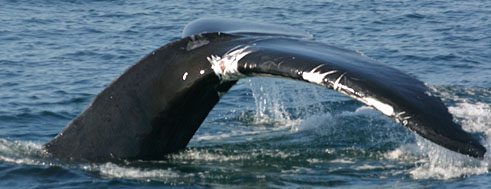FAQ
Call 1-800-900-3622 or hail the USCG on VHF 16.
This page attempts to address some of the most commonly asked questions regarding whale entanglements and the techniques and complications associated with a disentanglement.
Will disentanglement save the whales?
During a disentanglement attempt, there is no more pressing issue in front of a team than whether they can save this one whale and, if so, how they might do it. Disentanglement cases often involve dozens of experts working around the clock creating strategies, techniques, equipment and logistics for the next attempt. However, it is critical to understand that each entangled whale that is found embodies simply the most visible symptom of a much larger problem that plagues the remaining population of right whales and many other species — entanglements in fishing gear. An entangled whale is not an isolated event. The vast majority, at least 72 percent, of the right whales in the small surviving population in the North Atlantic have encountered entangling ropes in the ocean, as determined through photographic studies of their scars.
This number, which includes animals seen actually carrying gear, suggests a sharp increase in entanglements within this population during the past decade, notwithstanding the efforts of government and industry to reduce the rate of entanglement.
Research shows that the North Atlantic right whale’s slow recovery from the days of whaling has reversed and this species, once again, is decreasing in numbers. This time, however, it is at least partly due to the unintended consequences of increasing human industry in the oceans, including entanglements and ship strikes. The number of whales that sustain serious injury or death from these encounters may never be known, simply because they are most likely to die far from public view and cannot be counted; however, many more will die than can be rescued.
Without significant, rapid improvement in our commercial fishing technology and practices, entanglements will simply continue to a degree that the right whale population cannot withstand. Reversing this outcome is the responsibility of concerned citizens; one that we share with our elected representatives, regulators and with the fishing industry itself.
Why not get in the water and cut the whale free?

The flukes of an entangled humpback with line and mono-filament netting trailing behind
Swimming after a whale entangled in fishing gear is impractical and dangerous. Like most wild animals, whales do not seem to enjoy being approached closely by people. When feeling threatened, their options include swimming away quickly, diving or even breaching for protection (when in the water near a whale even the most innocent twitch of its massive body could easily injure or kill a rescuer). Many large whales cruise at about 4-10 miles an hour. Our best Olympiad swimmers can sprint up to 5 mph for short periods. One of the most dangerous aspects of diving anywhere near an entangled whale is the gear itself. Line and net has an incredible propensity for entangling anything that touches it. Humans are not nearly as efficient at diving and swimming as whales. Becoming entangled in the fishing gear attached to a whale would be disastrous, especially if the whale chose to dive. Other practical problems include the water temperature and the water clarity of many of their favorite habitats.
Cutting something must be better than nothing?

Deformed by its entanglement, this humpback was likely “cut free”leaving the most dangerous part of the entanglement on the whale
This is one of the most dangerous misconceptions facing an entangled whale. There is a distinct difference between cutting a whale free and disentangling the whale. People have reported cutting line from anchored whales, then watching them swim away. This very innocent and well-intentioned act may do more harm than good. By cutting the lines that anchor a whale or cutting only the lines that are most visible or accessible, a person may be releasing an animal with the most lethal part of the entanglement still present. Days or months later, the CCS whale rescue team may get a report of such an animal and will face the challenges of trying to subdue and disentangle a free-swimming animal with very little gear to hold on to for traditional rescue techniques. After being freed from anchor, the lines left on the animal may hinder movement, feeding, cause severe infection through abrasion and/or become embedded within the animal.
What is a life-threatening entanglement?
For some populations of whales, entanglement is not uncommon. Many whales may blunder into gear and become temporarily entangled only to free themselves later. So not all entanglements are life-threatening. Long-term entanglements, entanglements that a whale is not likely to shed on its own, are candidates for disentanglement. Such entanglements often involve wraps of rope or net around at least one body part, such as a flipper, fluke or jaw. Judging the potential lethality of an entanglement is difficult and is aided by high quality documentation.
Why haven’t you gone out yet to save that whale? or What’s taking so long, isn’t the whale about to die?

This close-up shot of the upper jaw of right whale #1102 shows the infection created by an embedded loop of line. He likely became lethally entangled while feeding since whales generally open their mouths for food.
If a whale is able to make it to the surface to breath, it is likely going to live over the short-term. Also, we often receive reports of entangled whales late in the day, in severe weather or without a vessel standing by, making a response unlikely. Many whale species may spend part of their year fasting, and can survive for some time without feeding. In some cases, whales may be assessed with a non-lethal entanglement and will likely shed the gear on their own. CCS and network members will only intervene with whales that have a life-threatening entanglement. To monitor entangled animals, CCS depends upon documented, opportunistic sightings from fishermen, whale watch vessels, dedicated flights or research cruises.
If a whale is deemed to have a serious entanglement, one of the first steps taken during a rescue is to attach a VHF/satellite buoy to the gear entangling the animal. If the whale is lost, the weather turns bad or more resources are needed, the animal may then be tracked for more rescue attempts. Our research indicates that this buoy creates no further harm to the animal and may actually pull the gear free with the added drag. Without the option of tagging it could be many months before resighting the whale (or never).
Whales that do not die outright through drowning while anchored in gear may face equally devastating results once they pull “free” of the gear. Any non-biodegradable rope left on the body that the whale is unable to shed may cause decreased mobility and/or infection.
Do the whales know that you are trying to help them out?
So far, we have little information that would show such a phenomenon. Certainly, they are aware of the presence of a rescue team but just what they think of this is far from clear. As with any wild animals, whales may be very dangerous when afraid. While working close with a whale, rescue teams make every effort to keep themselves safe. Whales may react with fight or flight responses on a scale measured in tons. Whales may use their heads, flukes or flippers to defend themselves or may simply turn calm after a lengthy battle. In either case, whales are treated with a respect of their sheer power, as any wild animal should be.
Why is documentation such a big priority?
Without documentation, little can be learned about entanglements and how to prevent them. By understanding how, where, when and who gets entangled, we may be able to make better decisions regarding the ultimate solution to the problem: prevention. By documenting each entanglement fully, for example, we have found that many whales become entangled while feeding and are more likely to become entangled in any gear floating or suspended in the water column (as opposed to lying flat on the sea floor). Documentation also shows if the disentanglement has been successful or not and creates an understanding of the healing process.
Considering that 10-20% of the humpback and right whale populations may become entangled each year, the work of the rescue team becomes daunting. Even more alarming, CCS and New England Aquarium research on scars attributable to entanglements has shown that only 3% of these entangled whales are ever reported.
Why is standing by a whale so important?

A whale watch boat standing by an entangled whale – identifying marks become important in situations like this where the entanglement is not obvious and the whale is part of a group.
Nine times out of ten, if a boat does not stay with an entangled whale it will not be found by rescuers in the same day. Considering the vastness of the ocean and the mobility of a whale, it is no easy task to find a specific whale. Without standing by rescuers may have to wait until the the whale is found again, by chance. Because of this, standing by is considered the single most important step in disentangling a whale.
Standing by a whale is not necessarily easy. Depending upon the species and its behavior at the moment, whales may stay on a dive from 2-30 minutes (or much more) at a time, covering prodigious distances. If a whale is in an aggregation, following that particular whale can be challenging. Identifying the whale as an individual, using scars or the shape of the dorsal fin is helpful in this instance (entangling lines may not be easy to see or even invisible from above the waterline). Through educational campaigns boaters are encouraged to wait by the entangled whale from a safe distance and call the U.S. Coast Guard immediately. The Coast Guard will notify the disentanglement network and may request that the reporting vessel contact other vessels nearby to make a relay where a new vessel takes on a bout of standing by while the previous vessel retires.
What is a success? Why do we sometimes leave gear on a whale?
Removing any life-threatening gear from a whale is the main objective of any disentanglement operation. Add to that full documentation of the entanglement and safety (for people and whales).
This does not necessarily mean that every inch of line will be removed from a whale. Research has shown that a large number of whales become entangled every year but many shed the gear on their own (it is impossible to say how many entanglements end in fatality). During some rescue operations, some gear may be left on the whale with the understanding that the whale will likely shed that gear on its own. Line may be left in the mouth with the ends shortened, likely to be cast off naturally at the next bout of feeding. If line is embedded within the whale, the line may be shortened, allowing the wound to reject the foreign body at its own pace.
How do we know that whales are becoming entangled at such high rates?

This view shows the best angle for monitoring entanglement scars on the tailstock
By documenting each entanglement, researchers have been able to monitor evidence of previous entanglements on different populations of whales. Many entanglements invariably involve the tail stock of whales (where the flukes meet the body), leaving scars that may persist for years. By photographing tail stocks of humpback whales within the Gulf of Maine, for example, a rate of entanglement can be measured and compared between years. This may be the only way to measure the success or failure of management initiatives geared towards reducing and eliminating entanglements.

Our Work
Humpback Whale Research
Right Whale Research
Marine Animal Entanglement Response
Marine Geology Department
Water Quality Monitoring Program
Marine Fisheries Research
Seal Research
Shark Research
Marine Education
Interdisciplinary
Marine Debris and Plastics Program
Marine Policy Initiative
Cape Cod Climate Change Collaborative
Publications

